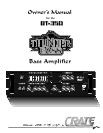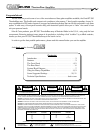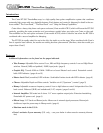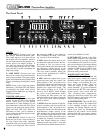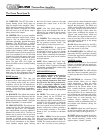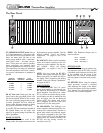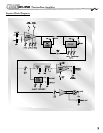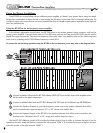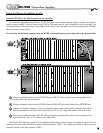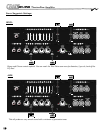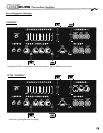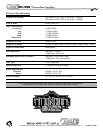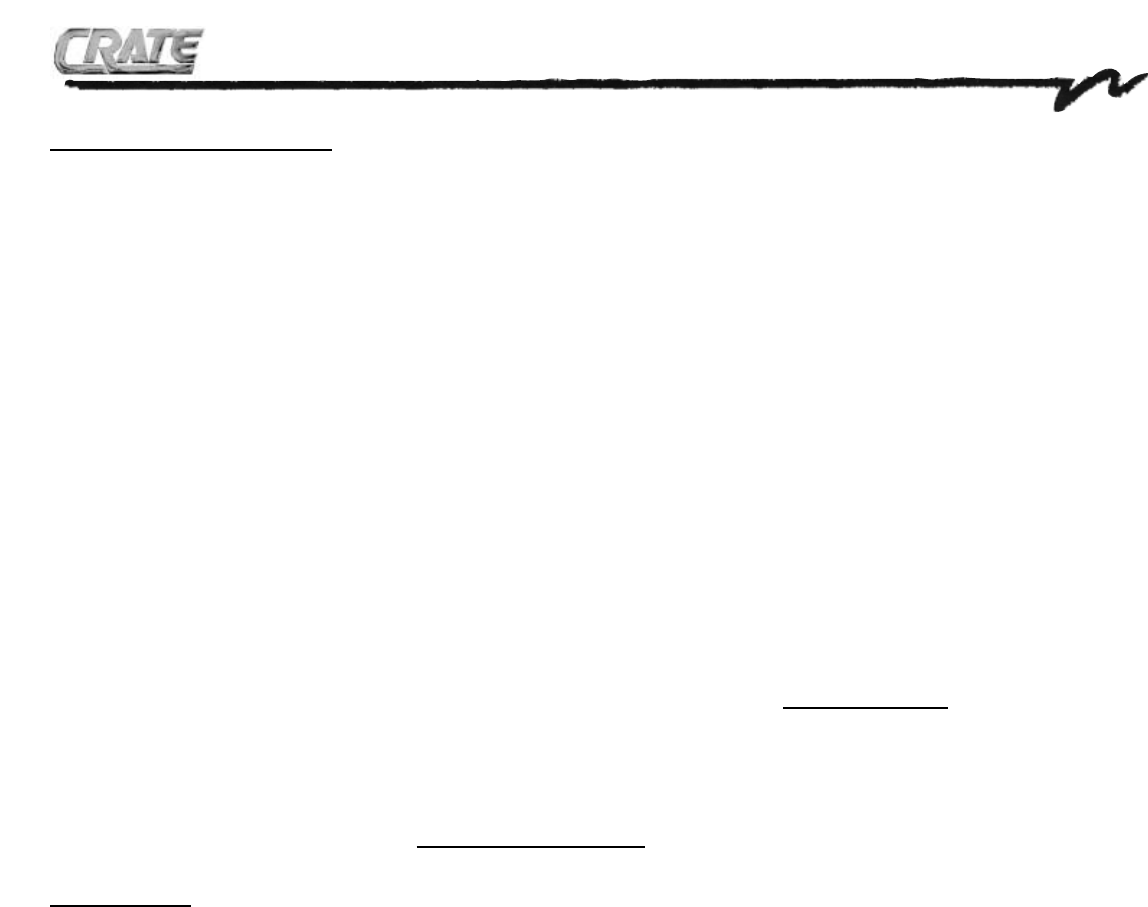
55
11. LIMIT LED: The BT-350 offers a
special limiting circuit which helps to
keep the output of the amplifier “clean”
when played at extreme volume levels.
When the Limiter is engaged, the Limit
LED will come on as the power amp is
being driven to full output.
12. LIMITER: When a power amplifier
reaches maximum output levels, it may
begin to “clip” its output signal, which
generates potentially speaker-damaging
distortion. The BT-350 has a special
APM (Automatic Power Maximizer) limit-
ing circuit which helps minimize this
problem by monitoring the power amp’s
output signal, keeping it below clipping.
This feature insures you that even as you
push your amplifier to its full 350-watt
output, the sound will remain clean and
pure. To activate the limiter circuit, press
the Limiter switch in until it locks in
place. The limit LED (#11) lights up
when the APM circuit is actually limiting
the signal.
NOTE: The limiter may be defeated,
which allows higher power output, but
there may be more distortion than the
.2% shown in the specifications chart.
BIAMP section:
13. FREQUENCY: This sets the
crossover point when using the BT-350
in the biamp mode (using two power
amplifiers, one for the low frequencies,
one for the highs). Please see the section
entitled “Using the Biamp Capabilities”
on pages 8 and 9 for more details about
biamping.
14. BALANCE: This adjusts the relative
level between the low frequency and the
high frequency biamp output signals.
Please see the section entitled “Using the
Biamp Capabilities” for more details
15. LINE OUT LEVEL: This adjusts the
output level for the Line Outputs jacks
on the rear panel (#31, 32), separately
and independently from the amplifier’s
Master level control (#10). The line out
feature can be used to send a low-level
(pre-amplified) signal to a mixing board,
recorder or external power amp. The
Line Out signal will have the same tone
and Chorus information as the Master
Level (speaker output) signal. Turning
the Line Out Level control to the right
increases the output level; to the left
decreases it.
NOTE: The Line Level signal is pre-
Effects Loop and therefore will not be
affected by any external signal proces-
sors connected to the Loop (see #33
and 34).
16. POWER: This heavy-duty rocker-
type switch is used to turn the amp on in
the “up” position, off when “down.” The
switch lights up when the power is on.
17. FOOTSWITCH: A two-button
footswitch (such as Crate’s CFP-2) can
be plugged in here to give you remote
on/off control of the graphic eq and the
chorus. When connected, the footswitch
overrides the front panel on/off switches
for these features.
NOTE: This is a stereo 1/4” jack: “ring”
controls the chorus, “tip” controls the
eq, and the “sleeve” is ground. Use only
a footswitch equipped with a stereo plug
(such as Crate’s CFP-2).
EQUALIZA
TION section:
The graphic equalizer can be used in
two different ways: 1: To fine-tune
your sound, make small adjustments
at the desired frequencies and leave
the EQ on for the entire performance;
2: For a completely different sound,
make larger adjustments and only
switch the EQ on when you want the
radical change (such as during bass
solos).
18. LEVEL: This serves as the overall
volume control for the BT-350’s on-
board 7-band graphic equalizer, and
only affects the signal when the EQ is on
(see #20). Use this control to adjust the
volume of the equalized signal: pulling
the Level control down from the center
position reduces the volume, pushing it
up from center increases it. The center
detent is “flat” (no increase or decrease
in level).
19. 40Hz – 10kHz: These slide controls
allow you to vary the output at the fre-
quencies shown under each control by
±12dB. The center position of each con-
trol is “flat” (no boost or cut): pushing a
control up from center boosts the output
at its given frequency; pulling it down
reduces that frequency. The 40Hz and
100Hz controls affect the lower notes of
your bass, changing how much bass is
felt. 250Hz through 1.6kHz affect the
upper notes, modifying the amount of
“punch” that comes across. 4kHz and
10kHz affect the upper harmonic over-
tones of your bass, such as the sounds of
your fingers in the strings or the strings
striking the fretboard.
20. ON: When this switch is in, the EQ is
active, and the settings of the controls
affect the sound of your bass.
21. ENABLED LED: This LED will only
light when the EQ is activated, showing
you that the signal will be affected by the
settings of the EQ controls.
CHORUS
section:
22. ON: When pushed in, the on-board
Chorus is activated and the signal pro-
duced by your bass will have the Chorus
effect applied to it.
23. ENABLED LED: This LED will light
when the Chorus is activated, giving you
a visual sign that the Chorus is function-
ing.
24. SPECTRUM: (or “crossover:”) This
unique feature allows you to adjust
which frequencies – either the entire
range or only the upper bass tones – are
enhanced by the Chorus effect. In the
fully counter-clockwise position the
entire range (or “spectrum”) will have
the chorus effect. As you rotate the con-
trol clockwise you change the roll-off fre-
quency for the Chorus, which allows the
lowest tones to come through “dry”
(without chorus applied). This is
extremely useful for maintaining full low-
end impact and definition during live
performances.
25. DEPTH: Adjust the overall amount
of the Chorus effect with this control: to
the left for a little, to the right for a lot.
26. RATE: Adjust the speed of the cho-
rus effect with this control: to the left for
slow, smooth “phasing” sounds, to the
right for faster, “vibrato” sounds.
The Front Panel (con’t):
BT-350
BT-350 ThunderBass Amplifier



